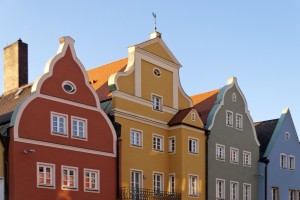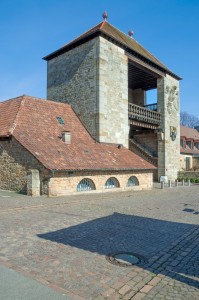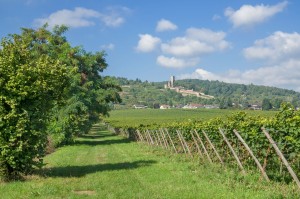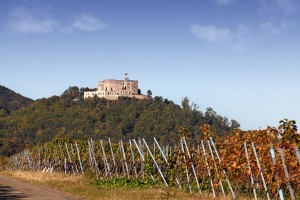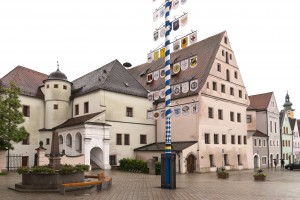Today we have a guest post from Houston-based Wine Educator James Barlow, CS, CWE. James’ article describes an amazing trip he recently took along the Wine Route in the Palantinate. Read on!
Nestled comfortably in the Haardt Hills, which is an extension of France’s Vosges Mountains, is the exquisite town of Neustadt. The town happens to be the central point for the 85-kilometer long German Wine Route (“Weinstrasse”) through the Palantinate. I recently spent two weeks in this fascinating area.
Established in 1935, this is the oldest of the German wine routes. The ‘trail’ is a windy road that delivers you past many of the great wineries and famous vineyard sites throughout the region. The Weinstrasse has the most expansive array of vineyards that I have ever encountered. The drive is breathtaking as it winds through historic wine villages such as Forst and Bad Durkenheim, which holds the largest wine festival in the world.
The picturesque Haardt hills and Palatinate forest provide a stunning backdrop for the various varietals grown in the Pfalz. The trail starts right near the French border of Alsace with the symbolic German Wine Gate in the town of Schweigen-Rechtenbach. It is made of sandstone which is also the main soil structure throughout the Weinstrasse. There is a
rather unique tasting room with an abundance of excellent wine to sample and buy. The trail ends at the House of the German Wine Route in Bockenheim an der Weinstrasse. The Rhine River flows lazily through the area as it continues onward through Germany.
One common theme with the wine of the Pfalz was that most of the wines were Trocken (dry). The typical American consumer often has a stigma with German wines thinking that they are all syrupy sweet and uncomplicated. The Pfalz wines are quite the opposite with most being dry and deliciously complex. The reason that dry wines are common throughout this region is that it is one of the hottest in Germany and therefore the grapes can ripen to a greater degree. The ensuing wines created can range from off dry to completely bone dry.
I had the distinct pleasure of traveling the entirety of the Weinstrasse as well finding quaint towns a little off the main road. St. Martin was one such town that we decided to visit. Our guide’s favorite winery, Weingut Egidiushof, was located here and recommended that we try the wines. The town’s name came from the huge sandstone church of St. Martin, with its statue of the saint overlooking the town.
The people of Weingut Egidiushof were very hospitable as we sat down in the small tasting room to try a plethora of selections such as Silvaner, Riesling, and Muller Thurgau. The whites had a common theme as all of them had a distinct tropical fruit bouquet, were un-oaked, and had good acidity. They produced some delightfully light reds with the Blauer Portugieser being the best of the bunch. It, in fact, was the wine that we drank while watching Germany eliminate Argentina in the World Cup Final. The wine was light bodied (like a Pinot Noir) with an easy acidity and vibrant fresh red fruits that reminded me of a Cru Beaujolais.
The crown jewel winery of the entire trip was actually in the Haardt hills of Neustadt. The winery was called Muller Catoir. It is managed by 9th generation owner Philipp David Catoir (pronounced Kat wah) and the vineyards have been in the family since 1774. Muller Catoir is part of the VDP system in Germany. This system holds the wineries to a higher standard of quality which include lower yields and typically hand harvesting.The quality wines at this winery were second to none.
The wine maker, Martin Franzen, is from the Mosel and makes a true effort to showcase terroir and varietal character. Five wines were tasted, starting with the Haardt Dry Riesling 2013. It showed an abundance of tropical fruit with vivacious acidity. The Haardt Muskateller (Muscat a Petite Grains) 2013 was brilliant and a wine to seek out for summer. My personal favorite was the Haardt Spatburgunder (Pinot Noir) 2012 which offered sleek acidity to pair with the delicious bright fruits and just a kiss of oak. Spätburgunder is beginning to gain traction in the wine world with low yield, boutique wines that can rival Burgundy in quality. The most interesting was the dessert wine Herzog Rieslaner Trockenbeerenauslese 2007.
Rieslaner is a cross of Silvaner and Riesling that is highly susceptible to Noble Rot. There is very little Rieslaner in the world and this vineyard is nestled in the Haardt hills, so a TBA wine is not able to be produced every vintage. This wine was exceptional and rivaled the sticky Selection de Grains Nobles wines of Alsace. The Haardt Riesling Kabinett 2013 was a surprise. It had just a touch of residual sugar, but the wine was perfectly balanced by the backbone of acidity. The minerality came to the forefront and gave the wine a striking personality. All in all, Muller Catoir is a winery that is offering whites and reds of impressive quality that should be sought out.
Just outside of Neustadt in Wachenheim was another excellent producer called Weingut Dr. Burklin-Wolf. This winery is considered one of the three main quality wineries of note known as The Three B’s, the others being Von Buhl and Basserman-Jordan. Dr. Burklin-Wolf had excellent Rieslings that had definite aging potential, especially in the 2013 vintage. The best of the selections tasted was the Wachenheim Altenburg Riesling 2013 which showed powerful acidity with precise citrus fruits and exquisite minerality.
The Pfalz wine country is an experience that one should definitely seek out if in Germany. The history and sheer volume of vineyards are enough to make a wine lover immediately start to geek out. I had the pleasure of trying several wines like a Schwarzriesling Rosé
and Rubin Cuvee Halbtrocken Sparkling that I have never seen in the states. The abundance of wineries throughout the wine road could keep any interested traveler busy for weeks.
Many can say that they have traveled through Paris, Champagne, and Burgundy, but how many can boast a trip through the picturesque Weinstrasse? I am thankful that I can.
Our guest author, James Barlow, CS, CWE, is a wine director of over 6,000 wines labels for a store owned by Spec’s Fine Wines and Liquors in Houston, Texas. He is also the author of the widely recognized wine blog thewineepicure.com. James is also a recent recipient of the CWE Certification (Congratulations, James!) and as such has taken on the duty of teaching the Certified Specialist of Wine course to fellow employees in hopes of having the best educated staff in the state of Texas. Way to go, James!
Click here to return to the SWE Website.
